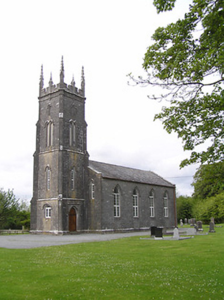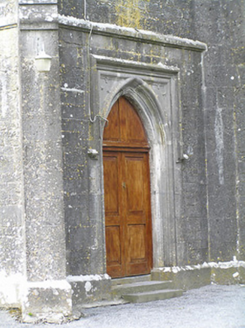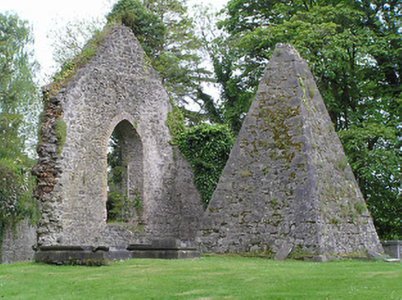Survey Data
Reg No
22204308
Rating
Regional
Categories of Special Interest
Architectural, Artistic, Social
Original Use
Church/chapel
In Use As
Church/chapel
Date
1825 - 1830
Coordinates
229181, 158042
Date Recorded
26/05/2005
Date Updated
--/--/--
Description
Detached Board of First Fruits style Church of Ireland church, built 1829, with four-bay nave elevation, four-stage tower to west, chancel to east, and transept to north incorporating vestry. Pitched slate roofs with carved limestone copings, cast-iron rainwater goods, and having cut limestone chimneystack to vestry. Cut and carved limestone finials, crocketed pinnacles and crenellations to tower. Snecked limestone walls with cut limestone plinth and with cut limestone corner buttresses and string courses to tower and chamfered cut limestone openings with hood mouldings. Pointed arch window openings, paired to third stage of tower, and Tudor-arched to ground stage of tower, all with replacement uPVC windows. Tudor-arched door opening to tower end of nave and pointed arched to tower, latter with carved limestone door surround comprising roll mouldings and label moulding with trefoil motif to spandrels, both with dressed limestone steps and having timber vertically-panelled double doors to nave and replacement timber to tower. Graveyard to site. Roughly-dressed stone ha-ha and cast-iron pedestrian gate flanked by monolithic limestone piers to south boundary. Carved limestone piers with steel gate to north-west entrance, and dressed granite piers with double-leaf steel gates to road entrance. Disused walled graveyard to south-east, disused graveyard with pyramidal monument and remains of ruin of church to south. Ruins of Cistercian abbey, built c. 1200, to south-west.
Appraisal
This church has succeeded in retaining its character despite the replacement of window frames. The finely-detailed carving, in particular in the spandrels of the tower door, are testament to both the highly-skilled craftsmanship of the nineteenth century and the high status accorded the Church of Ireland. It forms a pleasing ecclesiastical group with the mediaeval abbey, the ruined mediaeval parish church and several graveyards, and is a distinctive addition to the Kilcoolyabbey group of demesne buildings.





